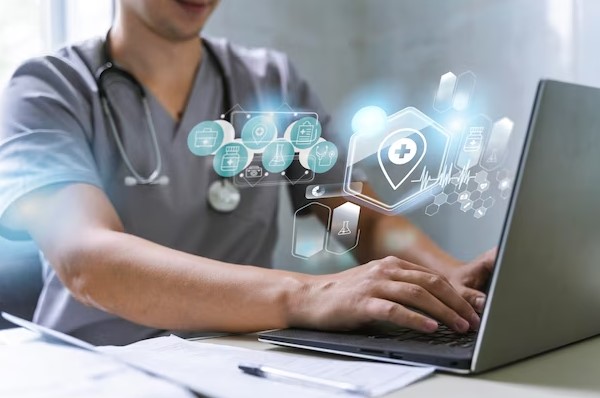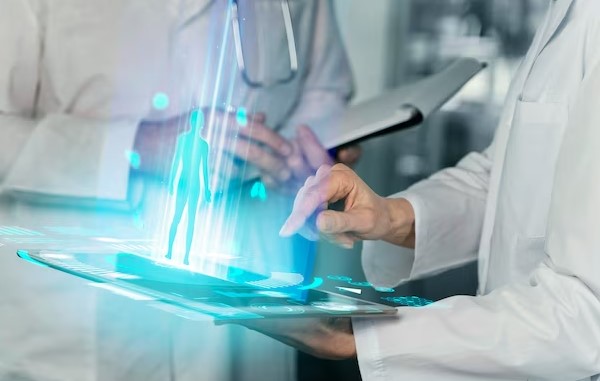In the world of healthcare, things are always changing. Many of these changes are because of new technology that helps us care for patients in better ways. This technology helps make health care better and better, and it changes very quickly. It doesn’t matter if you’re in the doctor’s office or a big surgery room – this new technology is changing everything. Now, we will talk about eight big changes technology is making in healthcare. These changes are important and are making healthcare better for everyone. So, let’s learn more about these great technological advancements in healthcare today.
Wearable Technology
In today’s digital world, wearable technology is significant in healthcare. These handy gadgets, like fitness bands or smartwatches, help us keep a check on our health by tracking heart rate, steps taken, sleep quality, and even stress levels. They act like personal health guides, alerting us when something is wrong. And it’s not just for fitness fanatics! Wearable devices are great for people with chronic illnesses, helping monitor conditions like diabetes or heart disease.
For instance, Avive, found at https://store.avive.life/, offers a life-saving wearable defibrillator providing instant aid to heart patients during a crisis. Wearable technology is the future, transforming our approach to health from reactive to proactive, making everyday health management as simple as strapping a watch to your wrist.
Telemedicine
Consider a world where your doctor is only a click away. That’s what telemedicine offers. It allows you to access medical care over the Internet. So, no matter where you live, medical advice is within reach. It is a blessing for people living in distant areas, the elderly, and those who can’t move around easily. They can now speak to a doctor, understand their health issues, and know how to treat them without leaving their homes.
The rise of COVID-19 made telemedicine even more important. It showed us the value of connecting with healthcare providers remotely, helping us stay safe in an era of social distancing. This ease of access to healthcare is the power of telemedicine, making it an essential part of modern medicine.
Artificial Intelligence in Diagnostics
AI is revolutionizing how we find diseases. How? Well, it uses machine learning, a type of AI that sifts through a lot of data, spots trends, and gives clear diagnoses. This tech can quickly identify illnesses such as cancer or heart disease. Take Google’s AI as an example. It can find signs of breast cancer in X-rays more precisely than a human could. So, what does this mean for patients? This quick detection can lead to early treatment, which can help patients recover quicker and better.
Robotics in Surgery
Step into the world where robots aid in surgeries! These robots are not only helpers but performers too. They handle medical procedures accurately, even better than humans, making surgeries safer. A standout in this field is the da Vinci Surgical System. This robotic hand is used across many areas of medicine, known for doing less invasive surgeries. What does it mean for patients? They get smaller cuts during operations, less discomfort, and bounce back faster post-surgery. This shift to robotic assistance in surgeries is exciting, as it brings better patient experiences and promising outcomes, stepping us forward in medical technology.
Electronic Health Records
Electronic Health Records, or EHRs, have given a facelift to how we manage medical data. Picture a world where mountains of paper files become a thing of the past. Now, doctors can find your health data with a simple computer click. This change makes healthcare smoother and faster and ensures everyone caring for a patient is on the same page. In short, EHRs bring all your health data together in one place. It helps doctors make the best choices for your treatment. It’s easy to see why EHRs are so important. They make healthcare more organized and efficient and ensure every patient gets the best care possible.

Virtual Reality in Patient Treatment
Virtual reality, or VR, is like a helping hand in patient care and recovery. It uses tech to create different settings and situations that can help patients in their treatment journey. For example, people with fears or stress disorders, such as PTSD or anxiety, can use VR as therapy. It can also help people recover from strokes or accidents. How? VR can mimic everyday activities, allowing patients to practice these tasks. They can learn to regain their skills in an environment that is both safe and under control. With VR, recovery is about getting better and regaining confidence and comfort in performing everyday tasks. It’s tech stepping up, making treatment not just a process but progress towards a healthier, happier life.
Nanotechnology in Drug Delivery
Nanotechnology is shaping the future of medicine, especially when it comes to delivering drugs to our bodies. Picture this: tiny particles, so small that they’re called nano, carrying medicine to exactly where it needs to go in the body. That’s what nanotechnology is all about. It’s like a GPS for medication. This method doesn’t just aim to get drugs where they’re needed most. Still, it also ensures other body parts aren’t unnecessarily affected. This breakthrough approach leads the way in creating what we call ‘smart drugs.’ These are set to change how we treat diseases in the future.
3D Printing in Healthcare
3D printing, also known as additive manufacturing, is significantly impacting healthcare. What is it? It’s a tech tool that builds solid objects from digital designs. So, how does it help in healthcare? It helps make things like hearing aids, dental implants, and artificial limbs! Also, it can create exact models of body parts. Doctors can use these models to plan surgeries better. And there’s more! Scientists are now testing 3D printers to make human tissues and organs. It sounds like science fiction, right? But it’s happening! In simple words, 3D printing is making healthcare better. It’s another step forward in using tech to keep us healthy.
Conclusion
Technology has indelibly altered the healthcare landscape, transforming it into a dynamic, precise, and patient-centered domain. It’s not just about combating disease; it’s about proactive health management, personalized treatment, and enhanced patient experiences. As we gaze into the future, one thing is certain: technology will continue to play a vital role in shaping healthcare.




